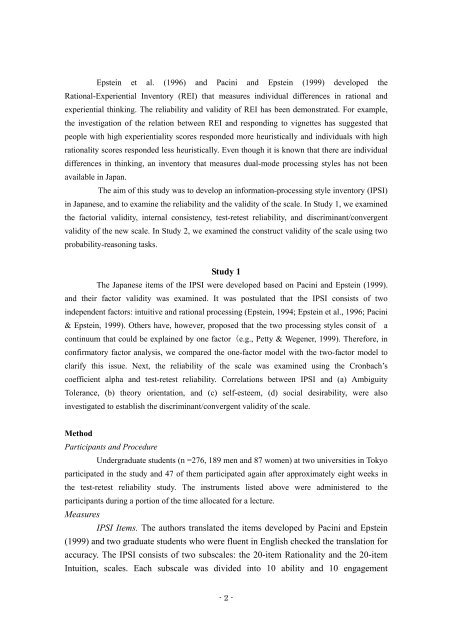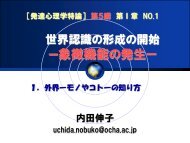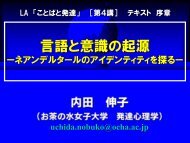Development of Rational and Intuitive Information-Processing Style ...
Development of Rational and Intuitive Information-Processing Style ...
Development of Rational and Intuitive Information-Processing Style ...
Create successful ePaper yourself
Turn your PDF publications into a flip-book with our unique Google optimized e-Paper software.
Epstein et al. (1996) <strong>and</strong> Pacini <strong>and</strong> Epstein (1999) developed the<br />
<strong>Rational</strong>-Experiential Inventory (REI) that measures individual differences in rational <strong>and</strong><br />
experiential thinking. The reliability <strong>and</strong> validity <strong>of</strong> REI has been demonstrated. For example,<br />
the investigation <strong>of</strong> the relation between REI <strong>and</strong> responding to vignettes has suggested that<br />
people with high experientiality scores responded more heuristically <strong>and</strong> individuals with high<br />
rationality scores responded less heuristically. Even though it is known that there are individual<br />
differences in thinking, an inventory that measures dual-mode processing styles has not been<br />
available in Japan.<br />
The aim <strong>of</strong> this study was to develop an information-processing style inventory (IPSI)<br />
in Japanese, <strong>and</strong> to examine the reliability <strong>and</strong> the validity <strong>of</strong> the scale. In Study 1, we examined<br />
the factorial validity, internal consistency, test-retest reliability, <strong>and</strong> discriminant/convergent<br />
validity <strong>of</strong> the new scale. In Study 2, we examined the construct validity <strong>of</strong> the scale using two<br />
probability-reasoning tasks.<br />
Study 1<br />
The Japanese items <strong>of</strong> the IPSI were developed based on Pacini <strong>and</strong> Epstein (1999).<br />
<strong>and</strong> their factor validity was examined. It was postulated that the IPSI consists <strong>of</strong> two<br />
independent factors: intuitive <strong>and</strong> rational processing (Epstein, 1994; Epstein et al., 1996; Pacini<br />
& Epstein, 1999). Others have, however, proposed that the two processing styles consit <strong>of</strong> a<br />
continuum that could be explained by one factor(e.g., Petty & Wegener, 1999). Therefore, in<br />
confirmatory factor analysis, we compared the one-factor model with the two-factor model to<br />
clarify this issue. Next, the reliability <strong>of</strong> the scale was examined using the Cronbach’s<br />
coefficient alpha <strong>and</strong> test-retest reliability. Correlations between IPSI <strong>and</strong> (a) Ambiguity<br />
Tolerance, (b) theory orientation, <strong>and</strong> (c) self-esteem, (d) social desirability, were also<br />
investigated to establish the discriminant/convergent validity <strong>of</strong> the scale.<br />
Method<br />
Participants <strong>and</strong> Procedure<br />
Undergraduate students (n =276, 189 men <strong>and</strong> 87 women) at two universities in Tokyo<br />
participated in the study <strong>and</strong> 47 <strong>of</strong> them participated again after approximately eight weeks in<br />
the test-retest reliability study. The instruments listed above were administered to the<br />
participants during a portion <strong>of</strong> the time allocated for a lecture.<br />
Measures<br />
IPSI Items. The authors translated the items developed by Pacini <strong>and</strong> Epstein<br />
(1999) <strong>and</strong> two graduate students who were fluent in English checked the translation for<br />
accuracy. The IPSI consists <strong>of</strong> two subscales: the 20-item <strong>Rational</strong>ity <strong>and</strong> the 20-item<br />
Intuition, scales. Each subscale was divided into 10 ability <strong>and</strong> 10 engagement<br />
- 2 -






